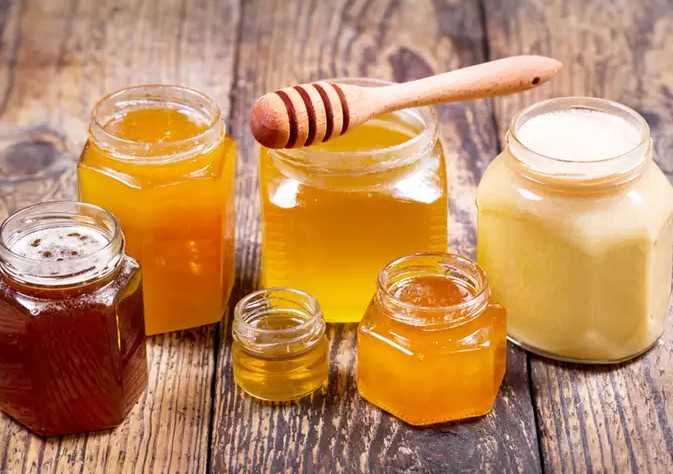
Honey is a natural ingredient used for its sweetness, energy and potential health benefits. It is mainly used for human consumption (but also in some cosmetics) either as pure honey or as an ingredient in other food products such as desserts, cereals and juices. There are hundreds of different honey types such as clover, acacia or manuka, depending on the botanical origin. This article explores how honey is made, describes its composition, and discusses research on its reported health effects.
The different types of honey
There are over 300 different types of honey worldwide. They differ in colour, aroma and flavour depending on the plant source where bees collect nectar. Some of the most well-known types of honey are manuka and acacia honey. Honey can be broadly categorised into raw and processed honey. When honey gets extracted from the beehive, it usually gets strained to remove wax and other non-honey particles. It is then available in its raw honey form which can be further heated and bottled to be available as processed honey, the form which is most commonly available in supermarkets. The heating and bottling process removes potential pathogens, but also the vitamins and antioxidants present in raw honey.
Health benefits: is honey good for you?
Honey has been used for millennia in traditional medicine for its potential antibacterial, anti-inflammatory and antioxidant properties. Honey specifically prepared for medical use can be applied topically for wound dressings. Honey’s low moisture content, hydrogen peroxide, and acidity (average pH of 3.9) are inhospitable to bacteria and give honey its antibacterial properties. The anti-inflammatory properties are thought to be due to antioxidant substances, although the amounts in individual honey samples differ depending on honey origin, composition and dose. Some evidence from individual and small-scale cell, animal and human studies also suggest that honey may be beneficial in the treatment of coughs, belly and digestive upsets. Finally, honey may contain spores of the bacteria Clostridium botulinum, which can cause serious infection in infants, leading to advice to avoid giving honey to children below 12 months of age.
Nigeria Spends $2bn Annually On Honey Importation
Despite a large number of studies on honey, most of these are not conducted in humans. Those studies investigating health beneficial effects of honey in humans, are small scale studies on preventing different diseases with different types of honey. Overall, the evidence that honey has specific health effects in humans is limited and not conclusive, with large-scale studies in humans lacking evidence to support current claims about its health promoting properties.
Honey versus sugar
Unlike sugar, honey contains vitamins, minerals and antioxidants; hence, it is easy to think that there are health benefits to honey compared to sugar. However, vitamins and minerals in honey are present in less than 1% of the recommended daily intake amount. To receive the health benefits from the low amount of vitamins and minerals present in honey, large quantities of honey would need to be eaten. Such quantities would exceed the recommended daily sugar intake by the World Health Organisation. Hence, a spoonful of honey will contribute to your energy metabolism due to its sugar content (without exceeding the recommended daily intake of sugar) yet is unlikely to have additional beneficial effects.
Finally, it can be argued that raw honey is better than processed honey, yet as the vitamin, mineral and antioxidant content in honey is minimal (per recommended portion size) the health benefits from eating raw honey over processed honey are likely minimal.
The Big Question: How much honey a day?
There is no recommended daily intake for honey specifically, however, due to its high sugar content, honey should be eaten in moderation. The World Health Organization suggests that free sugars (which means all monosaccharides and disaccharides added to foods by the manufacturers, cooks, or during cooking at home, plus sugars naturally present in honey, syrups and fruit juices) make up no more than 10% of a person’s daily energy intake. For an adult requiring 2000 kcal a day, 10% equates to no more than 200 kcal from free sugars, which is about 60 grams of honey if honey is used as the unique external source of sugar in one diet.
Follow us on Facebook/ twitter














